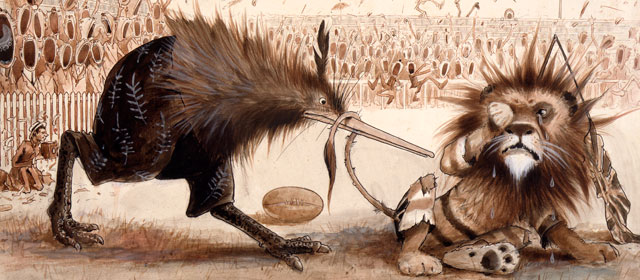Story summary
National identity is a shared understanding of the characteristics that distinguish one nation from other nations.
Māori, colonial and independent identities
Before European settlement, Māori did not have a unified national identity. A shared Māori identity began to develop after the United Tribes met in 1835.
After New Zealand became a British colony, the relationship with ‘Home’ (Britain) and the British Empire was a central focus. In the later 20th century a separate identity developed, based in the Pacific.
Land
Māori saw Papatūānuku (the earth mother) as the basis of life, and tribes’ identities were linked to their mountains and rivers.
With European settlement, a rural ideal developed. Farm workers were seen as strong and self-reliant. At first settlers saw the bush as threatening – but people came to appreciate New Zealand’s scenery and promote it to foreign tourists.
War
New Zealand participation in overseas wars was memorialised. Anzac Day – the anniversary of New Zealand troops landing at Gallipoli in the First World War – became a national day of commemoration.
Sport
Sporting successes – including All Black rugby teams, netball teams and athletes at the Olympics – have promoted images of New Zealanders as strong yet modest.
Politics
New Zealand was known for its innovative social policies, such as votes for women, old-age pensions and the welfare state.
New Zealand has also seen itself as setting a moral example on issues such as apartheid, French nuclear testing in the Pacific and nuclear-ship visits.
People
Early European visitors saw Māori as fierce warriors. Later some Pākehā romanticised Māori and Māori culture. New Zealand was viewed as having the best race relations in the world. From the 1960s Māori protested over land loss and for a greater role for Māori language and culture.
From the mid-1980s New Zealand became more multicultural.
Culture and arts
19th-century literature often romanticised rural life. In the early 20th century some writers and artists saw New Zealand as culturally desolate, and some moved overseas. From the 1930s people tried to establish a local culture. Favourite themes included men alone in rugged landscapes.
As New Zealand became more multicultural, this was reflected in its arts.
Symbols
Symbols of New Zealand identity can be official or informal. They include:
- the Southern Cross
- the silver fern
- kiwi
- sheep
- gumboots.





